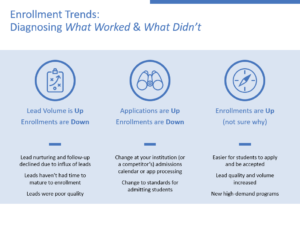It’s here, the moment of truth–Fall 2018 numbers are rolling in. The time when you find out whether all the work that you put into recruitment paid off. Whether you’re flat, up, or down in enrollment, now is the time to review what worked and plan for the year ahead.
Here’s a high-level guide for diagnosing what worked, what didn’t, and how to adjust your strategy for 2019.

Lead volume is up, but enrollments are down
Leading up to Fall term, you may have noticed lead volume was a lot higher, but now that census data is in, you’re not seeing that higher lead volume translate into higher enrollment. There are a couple potential causes for this:
- With more lead volume coming in, were your admissions teams able to scale up and work with each of those prospective students the same way they were at lower volumes? Did you add staff to scale up? Were you able to respond to every lead, or were you focusing on the more qualified ones who went ahead and started to apply? As you grow lead volume, following up with each of those leads becomes even more important. 75% of students we’ve surveyed say they expect to hear back within 48 hours before their perception of the quality of your institution is negatively affected. Bringing in more lead volume is great, but make sure you have a plan for follow-up in place.
- Did the increase in leads start to build just before Fall term? If so, maybe they just haven’t had a chance to mature to enrollment. Depending on the degree or student you’re recruiting for, it can take anywhere from 3-18+ months for a student to enroll (3-9 months for community colleges, 6-12+ months for undergraduate, 9-18+ months for graduate, 9-24+ months for PhD students). If leads come in just before Fall, students may not have enough time to complete the application process for the upcoming term.
- You were getting more leads and the issue wasn’t following up with them – they just weren’t quality. When it comes to marketing and leads, more is not always more. Look back on the year leading up to Fall to understand where your leads came from and assess their quality. Some of the best marketing strategies focus on proven marketing channels known to generate enrollments, but a lot of our clients report that their previous marketing agencies only cared about generating leads (or visits to their website), and they didn’t report or measure whether that traffic converted to enrollment. With fewer, high quality leads you can generate just as many (or more) enrollments.
Applications are up, but enrollments are down
You received more applications this year, but enrollments are down, and your yield rate is unusually low.
- Take a look at this year’s admissions calendar and the key milestones like admitting students and turn-around time on applications. Did anything change? Something as simple as a top competitor admitting students earlier than you did this year could have an impact on yield. With students applying to multiple institutions at once, they may decide to go to the school that communicates regularly and processes their application in a timely way.
- Were there any changes to your standards for admitting students this year? Perhaps rankings had something to do with that or perhaps existing programs added extra requirements. With more institutions waving standardized testing requirements, students may opt to go to an institution that makes it easier for them to apply. Take stock of your admissions policies, your calendar and the overall experience for students after they applied to see if you can identify a source for the decline.
Enrollments are up, although I’m not sure why
First, congratulations! This is a fête worth celebrating. In order to be able to replicate your success, spend some time getting to know what drove that success!
Applications are down, but enrollments are up. Was this driven by one or a few of the following circumstances?
- Our admissions team admitted students faster and more efficiently
- We decreased our admissions requirements which means more students were admitted and enrolled
- We added a start date, so students had an extra opportunity in the year to begin classes which organically grew enrollment
Leads are down, but enrollments are up. This could be caused by any of the reasons listed directly above, plus…
- The quality of our leads increased
- We’ve added new programs that are in high demand
Leads, applications and enrollments are up! Well, hooray! You’re firing on all cylinders.
Looking back at your enrollment funnel after a term can tell you a lot about the path you should be charting in the year ahead. Time is of the essence, so it is important that you act quickly because it can take anywhere from 3-18+ months to affect change. Get started by reserving October for reviewing data, diagnosing trends, and planning for the year ahead. Come November, begin preparing for and rolling out changes. While it will be early to see the full effect of your changes on enrollment, January is when you’ll get to see the early signs of your new plan taking effect with a lot of students doing research or inquiring about programs in the new year. Spring and Summer semester should then start to show signs of improvement, with Fall semester being a good indicator of your new strategy.